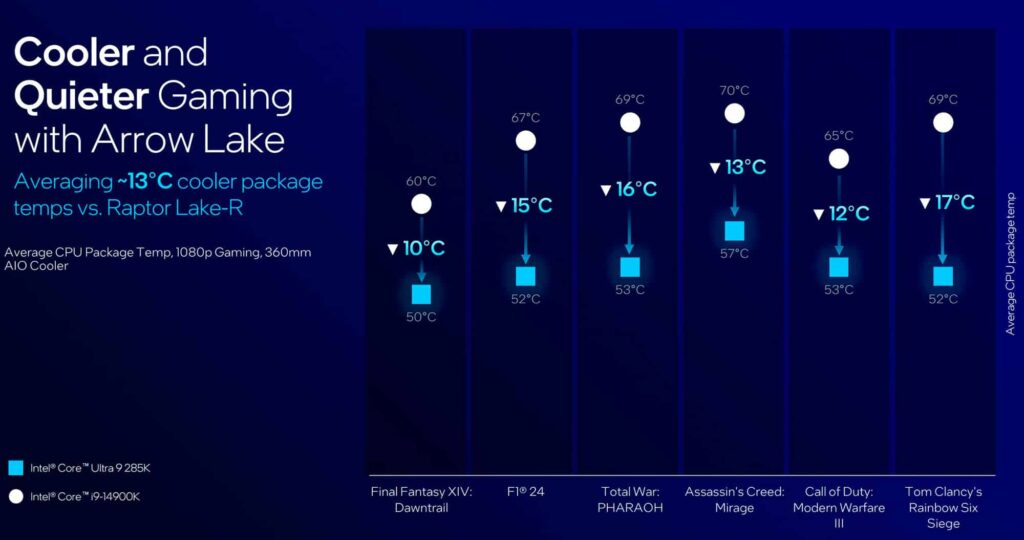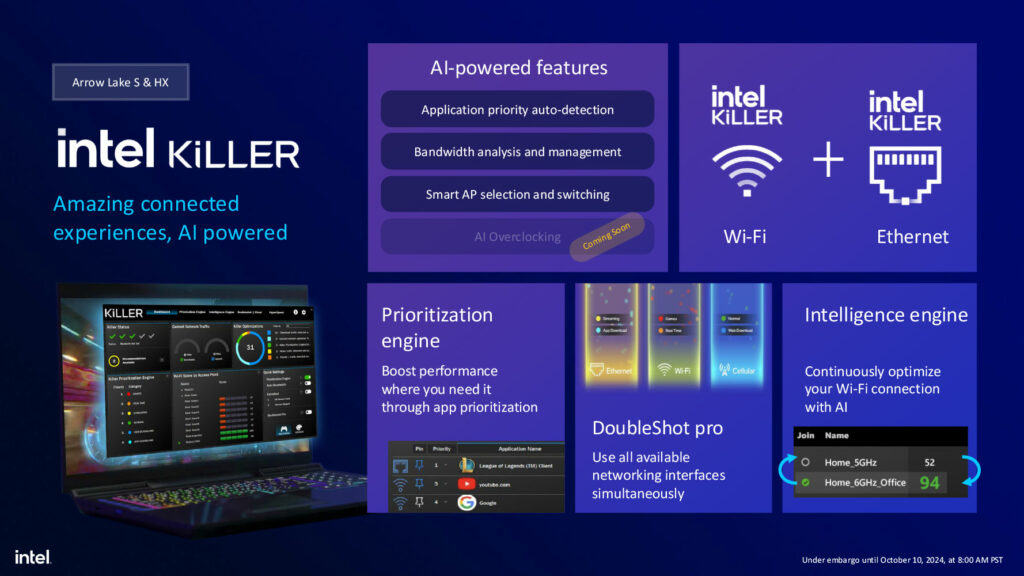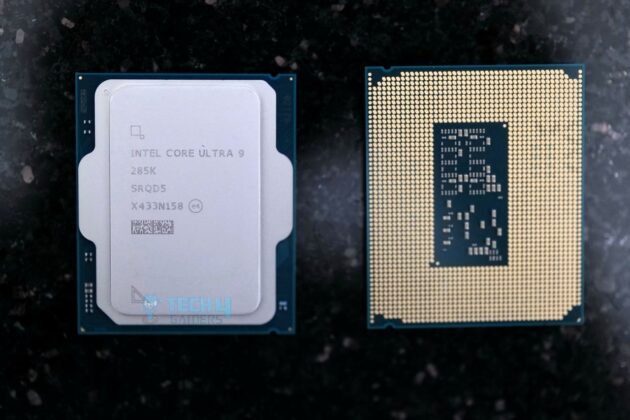Now That's Disappointing!
Review Summary
Intel’s Core Ultra 9 285K is a powerful flagship processor built on the advanced 3nm node, featuring 24 cores (8 Performance and 16 Efficiency cores) that does good in multi-threaded tasks like rendering and encoding. Priced at $589, it’s more costly than some of its competitors, and its requirement for a new LGA1851 motherboard may put off those looking to upgrade from recent Intel models. While the processor is generally good for productivity, its gaming performance, and inability to beat Ryzen 9900X, 9950X, and its own predecessor in some benchmarks make it hang in the middle. You’re paying flagship money for not-so-flagship performance.
Hours Tested: 6
Overall
-
Productivity - 8.5/10
8.5/10
-
Gaming - 7/10
7/10
-
Efficiency - 9/10
9/10
-
Value - 7/10
7/10
Pros
- Excellent Multithreaded Performance
- Efficient Power Consumption
- Advanced Memory and PCIe Support
- Competitive Rendering Benchmark Scores
Cons
- Inconsistent Gaming Performance
- Expensive Upgrade Path
- Limited Single-Threaded Performance
I am finally delighted to have the Core Ultra 9 285K processor and cannot wait to share all the details with you. Arguably, it is the first genuine next-generation desktop CPU from Intel since the release of the 13th-generation Core Raptor Lake series. Intel intends to include several technological advancements, which it first introduced through the Core Ultra 1-series Meteor Lake, to the mobile platform with Arrow Lake.
Therefore, it features new platform I/O, additional power and thermal enhancements, on-chip AI acceleration, and a new set of CPU cores. Furthermore, it brings a new desktop platform and socket called LGA1851. Henceforth, you’ll have to get a new motherboard with a desktop chipset from the 800 series.
In contrast to Zen 5’s 4 nm node, the compute tile of Intel’s first high-performance client architecture, Arrow Lake, is developed on TSMC 3 nm, a more advanced node. The Arrow Lake design concept aims to restore Intel’s position as a market leader in desktop CPU efficiency. Then, let’s put it through its paces on our test bench to see whether it’s possible.
Key Takeaways
- The Intel Core Ultra 9 285K is Intel’s new flagship processor, delivering impressive rendering speeds and efficient multitasking. However, its high price and average gaming performance may not appeal to budget-conscious or gaming-focused users.
- The Core Ultra 9 285K is an excellent choice for users prioritizing rendering and multitasking performance since it shows great results across multiple benchmarks. Moreover, its shift towards TSMC’s 3nm process node helps maintain thermal efficiency.
- If you’re primarily focused on gaming or are on a budget, this may not be the best option. Alternatives like the Ryzen 9 9950X or Intel’s Core i9 series provide better gaming performance and value at a lower price.
Let’s compare the specifications of the Intel Core Ultra 9 285K to those of other CPUs that cost about the same.
| Product | Core Ultra 9 285K | Core i9-14900K | Ryzen 9 9950X | Ryzen 7 7800X3D |
| Manufacturer | Intel | Intel | AMD | AMD |
| Price | $590 | $445 | $600 | $470 |
| No of Cores | 8+16 | 8+16 | 16 | 8 |
| No of Threads | 24 | 32 | 32 | 16 |
| Base Frequency | 3.7 / 3.2 GHz | 3.2 / 2.4 GHz | 4.3 GHz | 4.2 GHz |
| Max Frequency | 5.7 / 4.6 GHz | 6.0 / 4.4 GHz | 5.7 GHz | 5.0 GHz |
| Processing Node | 3 nm | 10 nm | 4 nm | 5 nm |
| L3 Cache | 36 MB | 36 MB | 64 MB | 96 MB |
| TDP | 250 W | 125 W | 170 W | 120 W |
| Architecture | Arrow Lake | Raptor Lake | Zen 5 | Zen 4 |
| Socket | LGA 1851 | LGA 1700 | AM5 | AM5 |
Architecture And Performance

The Intel Core Ultra 9 285K has a different name, but it’s really simply the Core i9-15900K. Intel appropriately renamed its Core family of processors for this generation following its naming scheme for mobile CPUs. Since its 12th generation Alder Lake CPUs, Intel has been using the same big.LITTLE design concept, and they have continued to do so with the Intel Core Ultra 9 285K.
With this architecture, larger Performance Cores (P-Cores) manage intensive workloads, while small Efficiency Cores (E-Cores) manage routine tasks in the background as necessary. The design makes the system far more efficient, particularly when idle. Utilizing Intel’s Arrow Lake architecture, the Core Ultra 9 285K has 24 CPU cores, including 16 Efficiency Cores and 8 Performance Cores.
In contrast to earlier generations, these cores remain single-threaded since Intel has stopped supporting Hyper-Threading. However, a 13 TOPS NPU is new to Arrow Lake and included in the Intel Core Ultra 9 285K. This is the same NPU present in Intel’s 2023 Meteor Lake laptop processors, which is a bit slower than Lunar Lake’s latest NPU.
Still, it leads to much better AI inference performance than a processor without a dedicated NPU at all. Intel has also downgraded clock speeds a bit, with the Core Ultra 9 285K featuring a max Turbo Boost of 5.7GHz, down from 6GHz in the Core i9-14900K. This lower clock speed means single-core performance won’t see much of a generational improvement this time, but 5.7GHz is still incredibly fast.
Power Efficiency and Processing Node

With Arrow Lake, Intel aims to introduce new technologies across the board and address the power draw issues that have afflicted Intel processors since Core Comet Lake, the 10th generation. In contrast to Zen 5’s 4 nm node, the compute tile of Intel’s first high-performance client architecture, Arrow Lake, is developed on TSMC 3 nm, which is a more advanced node.
Arrow Lake’s design philosophy strives to return Intel to the leading edge of efficient processors. Reducing power consumption significantly opens up new possibilities for customers, including overclocking, which Intel CPUs are naturally good at. So, even if generational performance or IPC increases are small, this makes it a more efficient CPU overall.
Memory Compatibility and Speed

Arrow Lake-S can accommodate dual-channel memory of up to 192 GB, with a density of up to 48 GB per DIMM. Intel claims that DDR5-8000 is the optimal overclocking memory speed, and it has built-in compatibility for JEDEC DDR5-6400. Beyond this, the CPUs can handle overclocked memory rates far faster. With the DDR5-9600 currently in the works, we may see memory rates above 10,000 MT/s throughout 2025.
LGA1851 Socket

Intel has introduced a new socket, LGA1851, with the Arrow Lake-S. Since Intel is only releasing unlocked K or KF CPU versions this year, the sole motherboard chipset type available is expected to be the top variant Intel Z890. So, you’ll need a new motherboard to go along with your new processor. It is expected that by 2025, Intel will have streamlined its processor model hierarchy and introduced more reasonably priced motherboard chipsets.
PCIe and Thunderbolt Integration

It also has an astonishing 48-platform PCIe lanes. With Intel’s revision, the CPU can now output 20 PCIe Gen 5 lanes, with 16 of those lanes dedicated to the PEG and 1 Gen 5 slot bound to the CPU for M.2 NVMe drives. Moreover, the CPU provides a second pair of Gen 4 x4 that can be utilised to power high-bandwidth onboard devices or routed out as an M.2 slot.
Furthermore, the CPU has a Thunderbolt 4 controller integrated into it, which can output a pair of 40 Gbps ports. It has 24 downstream PCI-Express Gen 4 lanes, a significant improvement over the Z790 chipset, which only had 16 Gen 4 lanes and 8 Gen 3 lanes. Lastly, the chipset features Wi-Fi 6 and a 1 GbE MAC.
Packaging and Unboxing
Intel Core Ultra 9 285K arrives in minimal packaging. Even though it seems to be an LGA1700 CPU, I can assure you that it will not be compatible with your older motherboard. The dimensions are the same for cooler compatibility, but the key notch is changed. To make room for those additional 151 pins, Intel reduced the island to the center of the land grid. Lastly, installing an LGA1851 CPU is the same and straightforward as an LGA1700.
Test Bench
Here’s what my test bench for the Intel Core Ultra 9 285K looks like:
- Processor: Intel Core Ultra 9 285K (Extreme Profile)
- Motherboard: MSI MPG Z890 Carbon (7E17v1A1)
- Power Supply: Corsair HX1200i Platinum
- Storage: Sabrent Rocket 4 Plus G 2TB
- Memory: Corsair Dominator Titanium 2x16GB 32GB DDR5-7200 CL34
- Graphics Card: Gigabyte RTX 4090 Gaming OC
- CPU Cooler: DeepCool Mystique 360
- OS: Windows 11 Pro 23H2 64-bit
Testing Methodology
- Used default Auto and Stock settings for all tests.
- Disabled any default performance boost options in the BIOS.
- Loaded EXPO and manually adjusted DRAM timings and voltage for each test.
- Left all other voltages on Auto.
- Ran the cooling system’s pump and fans at full speed (100%) during testing.
- Kept the graphics card in its stock settings.
- Updated the motherboard’s BIOS to the latest version.
- Used Nvidia driver 517.48.
- Monitored all sensors with HWinfo64
General Benchmarks
I began with general performance benchmarks to assess the processor’s performance across different types of tasks. In our general benchmarks, the Core Ultra 9 285K performs well in several intensive tests, aligning closely with other high-end processors and sometimes even far exceeding their performance.

The Intel Core Ultra 9 285K achieved the highest scores in compression (205,861 MIPS) and decompression (200,795 MIPS) among all tested processors.

Intel Core Ultra 9 285K showed great results with an impressive AES encryption speed of 659,768 MB/s, followed by AMD Ryzen 9 9950X at 678,118 MB/s.

Intel Core Ultra 9 285K achieved a calculation time of 180 seconds in the Super Pi 32M test, making it the fastest processor tested in this benchmark.

In the wPrime 1024M test, the Intel Core Ultra 9 285K completed the calculations in 44.169 seconds, showcasing its multi-threading capabilities, which is faster than most but behind the AMD Ryzen 9 9950X and 9900X.
Rendering Benchmarks
Rendering performance benchmarks were compiled for popular applications to show how well the Intel Core Ultra 9 285K handles demanding workloads.

Intel Core Ultra 9 285K scored 2240 in single-core and 40,943 in multi-core tests in Cinebench R23, outperforming all other processors in both metrics.

The Intel Core Ultra 9 285K scored 14,398,745 in the Corona test, outperforming all other processors except the AMD Ryzen 9 9950X, which had a total score of 15,221,914.

The Intel Core Ultra 9 285K completed the FryRender test in 31 seconds, making it the fastest processor among all tested.

The Intel Core Ultra 9 285K scored 2386 in single-core and 24,983 in multi-core tests, securing second place overall, just behind the Ryzen 9 9950X.

The Intel Core Ultra 9 285K completed the V-RAY test in 11 seconds, outperforming all other processors and achieving the best score in this benchmark.
Gaming Performance (1080p)
Let’s look at the gaming performance, tested at 1080p resolution and the Ultra preset (or equivalent). The list of tested games:
- Alan Wake 2
- Cyberpunk 2077
- Elden Ring
- F1 2024
- Hogwarts Legacy
- Spider-Man Remastered
- Starfield
- The Last Of Us

Intel’s marketing for Arrow Lake highlights similarities with Raptor Lake in gaming performance rather than surpassing it, and this is how it is being reflected in these benchmarks.
In Cyberpunk 2077 and Alan Wake 2, the Intel Core Ultra 9 285K had lower frame rates than its predecessor, the Core i9-14900K, and AMD’s Ryzen 7 7800X3D. At 1080p, these two competitors outpaced the Ultra 9 285K by up to 14%. Even in the Elden Ring and F1 2024, the Core Ultra 9 285K lagged behind, with the Ryzen 7 7800X3D and Core i9-14900K ahead by around 6%.
While it’s tempting to conclude that the Core Ultra 9 285K may not be a good gaming CPU compared to competitors, it did show standout performance in Spider-Man Remastered. In this benchmark, the Ultra 9 285K was 12% faster than the Ryzen 7 7800X3D and 10% faster than the Core i9-14900K. Despite this result, I would say that the Ultra 9 285K’s gaming performance remains inconsistent.
Thermals and Power
Finally, a look at thermal performance and power consumption:

During a 30-minute Cinebench R23 multi-core test, the Intel Core Ultra 9 285K consumed an average of 198 watts which was expected given its 250W rating. The thermal efficiency is slightly commendable compared to the previous generation, peaking at 77°C while handling this power draw. In comparison, the Ryzen 9 9950X consumed around 202 watts and reached lower temperatures at 72°C
Should You Buy it?
Still in confusion? Let me break it down for you.
Buy it if
✅ You need high-level multi-threaded performance: The Core Ultra 9 285K excels in rendering tasks and other multi-threaded workloads thanks to its efficient 8+16 core configuration.
✅ You prioritize power efficiency: With the 3nm process and updated architecture, this CPU keeps power draw under control compared to previous generations.
✅ Efficient rendering and encoding are priorities: If you work with 3D rendering or video encoding, the core architecture and improved efficiency make it a valuable choice for professionals in content creation.
Don’t Buy it if
❌ Gaming is your main focus: If gaming is your top priority, the Core Ultra 9 285K falls behind AMD’s Ryzen 7 7800X3D and even Intel’s Core i9-14900K in many game benchmarks.
❌ You’re on a budget: At $589, this chip requires a new motherboard and may not be a great choice for those upgrading from a recent 13th or 14th-gen Intel processor.
❌ Single-threaded performance is critical: While still powerful, the slightly reduced Turbo Boost speed means single-threaded tasks may not significantly boost over the previous generation.
My Thoughts
I find it difficult to see the Intel Core Ultra 9 285K results without being confused. The current state of Intel’s Core Ultra 9 285K is somewhat uneven. According to the nature of the test, the Ultra 9 285K is either substantially slower, much faster, or much slower than its direct competition and predecessor. These somewhat random wins and losses make recommending the processor complicated.
Depending on how you intend to use it, it could be the easiest or most confusing selection in its price section. While it may not be the worst, it is certainly not the best. In my opinion, Intel somewhat downgraded the performance of this CPU by discontinuing Hyper-Threading and reducing the maximum Turbo Boost speed.
They did this so the chip could have an NPU, but it’s a bit of a stretch for a desktop CPU as it will always have a dedicated GPU. Perhaps optimization could be the problem with the gaming benchmarks. It’s not usually common for a CPU to surpass competitors by as much as 15% in one game and as much as 12% slower in another.
Future software updates and improved optimization could fix some of these issues, which can increase the Ultra 9 285K’s recommendability. Until then, it’s still a better choice than many of its competitors. However, since it is priced at $589 and you have to buy a completely new motherboard for this processor, it is hard to recommend it to anyone already with a 13th or 14th-gen processor.
Thank you! Please share your positive feedback. 🔋
How could we improve this post? Please Help us. 😔
[Editor-in-Chief]
Sajjad Hussain is the Founder and Editor-in-Chief of Tech4Gamers.com. Apart from the Tech and Gaming scene, Sajjad is a Seasonal banker who has delivered multi-million dollar projects as an IT Project Manager and works as a freelancer to provide professional services to corporate giants and emerging startups in the IT space.
Majored in Computer Science
13+ years of Experience as a PC Hardware Reviewer.
8+ years of Experience as an IT Project Manager in the Corporate Sector.
Certified in Google IT Support Specialization.
Admin of PPG, the largest local Community of gamers with 130k+ members.
Sajjad is a passionate and knowledgeable individual with many skills and experience in the tech industry and the gaming community. He is committed to providing honest, in-depth product reviews and analysis and building and maintaining a strong gaming community.


 Threads
Threads






![Ryzen 7 5800X Is Currently Selling For Its Lowest Price Yet The Ryzen 7 5800X3D was the first 'X3D' processor ever. [Image Credits - AMD]](https://tech4gamers.com/wp-content/uploads/2024/04/AMD-Ryzen-7-5800X3Ds-Release-218x150.jpg)
